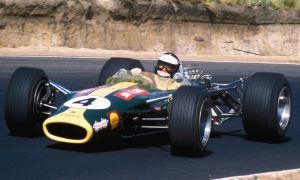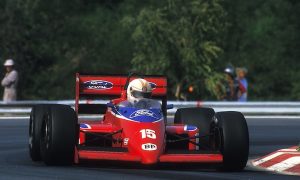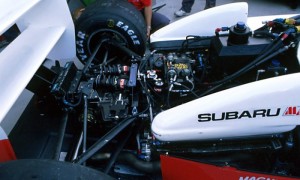Seeing him still perfectly fit, juvenile and extremely active, one wouldn’t say that Mauro Forghieri is a ‘veteran’. Nonetheless, the man that led Ferrari’s technical and sporting fortunes for almost three decades (from 1961 to 1987) and who is regarded as one of the brightest engineers of his generation, turned 80 last week, on 13 January.
These days, he clearly has more time to devote to his family and to indulge in golf and water sports, but the man has never stopped working and being involved in technical projects, now as an independent engineer. His company, Oral Engineering, is regularly consulted by clients such as BMW, Bugatti or Aprilia. And he has recently being involved also in the restoration of the “affreschi” of a 17-century palace near Modena, certainly a new experience.
In 1961, following an internal upraising, Enzo Ferrari fired the entire management team of his company, including top engineers Carlo Chiti and Giotto Bizzarrini. Forghieri was then a 27-year-old trainee engineer at Maranello, fresh from his studies at Bologna University. Almost overnight, he found himself appointed the new technical director.
“I was scared,” Forghieri remembers. “And I told Ferrari so, but he reassured me by saying he was behind me. He taught me that you never have to feel defeated before-hand.”
The relationship with the Commendatore had its ups and downs, but the string never broke: “We were both from Emilia, same passionate personality and warm blood. Of course, sometimes he shouted at me and vice-versa, but there was a great deal of respect between us. It is fair to say that he ‘created’ me and never destroyed me, contrarily to others…”
Since 1962 (and up to a few months before Ferrari’s death in 1988, when he left for Lamborghini), Forghieri has been the mastermind behind all Ferrari’s racing cars; periodically, he would also take on the top managerial duties at the Scuderia. In his tenure, the Prancing Horse brought home no less than 17 world titles (drivers’ and manufacturers’) in F1 and sportscars. A workaholic and a sparkling creator, his flamboyance gained him the nickname of ‘Furia’ which needs no translation.
His preferred design remains the 330 P4, which took a stunning win at the Daytona 24 Hours in 1967 and is arguably one of the most beautiful racing cars ever built.
“Aesthetics is one thing and functionality, another,” he admits. “But when the two meet, when a design is beautiful and works well for the purpose it has been designed, it is just great. It’s true for a car, for a building, for a piece of furniture, for everything.”
As a counter-example, he cites the 312T4 that took the title in 1979 with Jody Scheckter: “We still used the flat boxer 12-cylinder engine and we had to develop a design that could use the upper aerodynamics. The car looked frankly awful. First thing that Ferrari told me when he saw it was ‘Mamma mia, how ugly!’ But after conquering the title, he came back to me saying: ‘You know, Mauro, now that I’m getting used to it, I’m starting to find it pretty!’”
Forghieri reckons that he has a special affection also for the line of the 312T Formula 1 cars, the ones that allowed Niki Lauda and Scheckter to take three world titles in the second half of the ‘70s. He also feels proud of the 126C2, the first Ferrari of the turbo era and the car that gave him the win that thrilled him most.
When he has to pick one, there is no hesitation: “Monte Carlo 1981, when Gilles Villeneuve kept everyone at bay with such a heavy, superpowered car such as the 126C, not at all suited for a street circuit. I felt particularly proud when Colin Chapman came to congratulate me after the race, also because I have always had a lot of esteem for Colin and Lotus’ innovation philosophy.”
By that time, F1 was the only racing focus for Ferrari, having abandoned the sportscar arena in 1974, a decision Forghieri regretted: “Somehow, I always thought that we had betrayed the company’s DNA…”
In 27 years at the Scuderia, Forghieri has of course come across many drivers, and many of them left a mark on him. He doesn’t hide that his preferred one was Chris Amon, “an extraordinarily talented driver and very good at setting up a car”, but his short list also includes Lorenzo Bandini, “a very committed team member”, Scheckter, Clay Regazzoni, “a hard worker and excellent tester, contrarily to his reputation”, and Willy Mairesse, “the bravest of all”.
Two others have a special spot in his heart: “Niki Lauda was extremely effective and rationale, almost emotionless. But sometimes, his human side showed out, like at Fuji in 1976, in that final and decisive GP under heavy rain. After the Nurburgring drama, and his premature return to racing, at Fuji Niki simply cracked. I offered him to fake a technical failure, but he refused. ‘No Mauro, it’s not the electrics, it’s me’. He proved what kind of material he was made of, what kind of man he was and that day, I felt proud leaving the circuit at his side. Gilles Villeneuve was a completely different kind of man, adorable. His only aim was to give it all, always, whatever the circumstances and the car he had under his butt. He was always 20% over the limit, and that meant risks, accidents and technical failures. Not an easy thing to manage for anyone having the responsibilities I had at the time, but what a great driver and a great chap he was.”
Not surprisingly, someone like Forghieri is quite critical with today’s Formula 1. He admits he doesn’t like today’s standardized car design, dictated by computers, nor the Tilke-style circuits, nor the ‘formatted’ drivers who are told what to do on a track by the pitwall crew over the radio and what to tell the press by a PR advisor. But his fiercest criticism is for the current engine rules: “Technical progress is made through research, testing and adjustments. The current rules are aimed at freezing all that, it is total nonsense!”
By Alfredo Filippone









